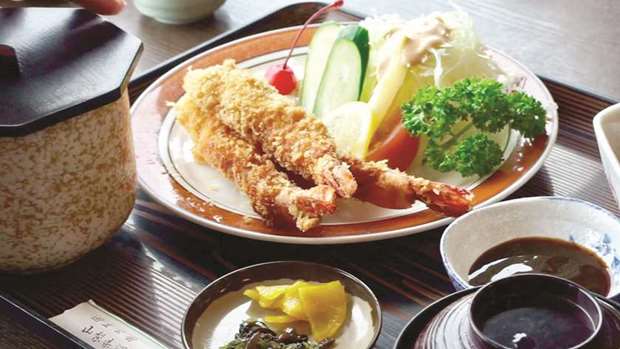Last year, Japanese cuisine was recognised as one of the top three cuisines by the United Nation’s cultural organisation as a traditional cuisine next to French and Mexican cuisines. Japanese cuisine is dear to me as well, I love to savour this cuisine and also like to cook it. To me Japanese cuisine is all about the simplicity. Courses include a few small items, often fresh and with simple flavours. Japanese chefs work with top quality ingredients and do as little to the food as possible to bring out the colour and flavour. Japanese food is much about the preparation and presentation as it is the food itself. A great deal of thought goes into every item served. While we all think of only four main seasons, Japanese chefs consider dozens of seasons and carefully select ingredients that are in their prime flavours that represent that specific period. Tasting these flavours, connects Japanese eaters with past years. January 7 is also celebrated as National Tempura Day.
Once prepared, the food is carefully plated and the finished dish often looks like a work of art. The highest number of international awards are bagged by a Japanese restaurants around the world, firstly because it looks beautiful and secondly it tastes fresh. The origin of Tempura, batter frying, in Japan dates back to the 16th century. Portuguese travellers brought the concept of batter frying. The word ‘Tempura’ is derived from the Latin word ‘Tempora’ which refers to ‘The Ember Days’ when Catholics refrained from eating meat. The first Tempura-dish was beans tempura. The shrimp Tempura was prepared and gained popularity. Shrimp Tempura is one of my all time favourite Japanese dish. Shrimp Tempura is often served as an appetiser but can also be paired with a cold noodle dish like Zaru Soba.
The trick to make a perfect Tempura is to get the Tempura batter right. A slight deviation in the batter recipe will end up in a soggy batter. Shrimp Tempura is a three step method. Fist step is to prepare the shrimp, second is to prepare the batter and the last step is to crisp fry the Tempura. Vegetable oil or canola oil is commonly used to prepare tempura, but traditionally sesame oil was used earlier.
How to prepare the shrimps
The shrimps need to be prepared in a certain way to keep them straight during the cooking process. First remove the shell but leave the tail intact. Tail on shrimp looks better and is easy to handle while batter coating it and frying it. To prevent the shrimps from curing up, place them on a cutting board belly side up. Make four to five vertical incisions all along the belly. Do not slice all the way, just about half way will do the job. These incisions will also make the shrimp much longer than their actual size. After the incisions flip the shrimp on the sides while pressing down. Start from the tail and work your way up to the top. Be careful not to squeeze too hard, but it should be firm enough where you will hear a slight snap. Arrange in a separate tray to batter coat later on. Make sure there is no excess moisture in the shrimp, especially in the tails, as water gets trapped in the tail and then causes the hot oil to spatter. I always pat the shrimps with paper towel to remove any moisture from them.
Heat up cooking oil to medium high heat. Make sure it is hot enough before you start deep frying the Shrimp Tempura. The oil should smoke just a little – that is how you know it is ready for frying. The batter needs to be made with flour and eggs. I will share the recipe below. You can also coat some pinko breadcrumb after batter coating to make it even more crispy after frying.
The most common way to eat Shrimp Tempura is to serve it along the Ten-Tsuyu dipping sauce. The sauce is usually made with fish-stock and soya sauce. Grated daikon radish or ginger may be served with it to add some zing to the sauce. Some also prefer to eat Tempura with just dipping salt, plain sea salt or mixed with other spices such as matcha.
Shrimp Tempura
Ingredients
Shrimp (16-21) 1 lb
Corn starch ¼ cup
All purpose flour 1 cup
Water 200 ml
Eggs 1 no.
Vegetable oil to fry
Soy sauce 1 tsp
Method
First step is to prepare the shrimps and give them small slits to avoid them to curl while cooking
Use the above mentioned method to prepare the shrimps for cooking, to test how you’ve cut the shrimps, you should be able to lay them flat on their belly without the shrimp curving or rolling over
Pat dry the shrimps to remove excess moisture using kitchen paper towel
Arrange in a separate tray/ bowl and keep aside
Fill the deep fat fryer or heavy bottom pot with vegetable/ canola oil to about 350 degree Fahrenheit
To check the oil temperature stick a wooden chop stick in oil, If it boils around the wood, the oil is ready for frying
While the oil heats up, prepare the batter, in a bowl combine egg with 200 ml water and whisk to combine
Ad flour in a separate bowl and pour the egg water mixture and slowly mix until the flour is combined, few lumps are ok in the batter
Do not over mix the batter and preferable use a wooden chop stick to combine it, place the batter bowl on ice bath
Dust the prepared shrimps in corn starch and then dip in the batter to cover the shrimp flesh
Remove excess batter with the side of the bowl and drop the shrimps in heated oil
Do not crowd the fryer by adding too many shrimps
Fry till light golden brown and crispy, serve hot with soy sauce on the side
Note: To make a vegetarian version of this dish replace the shrimp with long cuts of vegetables like baby carrots, baby corn, green beans and remove the egg from the recipe.
* Chef Tarun Kapoor,
Culinary Mastermind, USA. He may be contacted at [email protected]

APPETISER: Japanese dishShrimp Tempura is often served as an appetiser. Photo by the author


